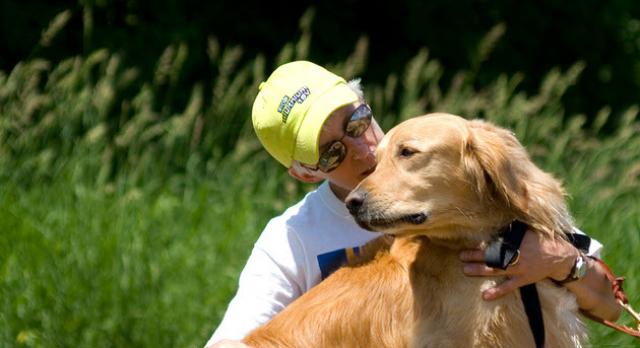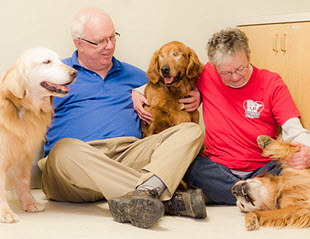Foster care provides a home environment that helps RAGOM determine what a dog needs in his or her forever home. A foster home also provides the adoptive family with helpful information about the dog to ease transition and ensure a successful adoption.
The number of RAGOM foster homes directly affects the number of dogs we can rescue. And because many of our dogs are former breeders with little to no socialization, we especially need foster homes with no young children and at least one confident, medium- to large-sized dog to act as a mentor.
We always need more foster homes, even those that can accommodate only one or two dogs per year. Foster families:
- Provide a temporary home and demonstrate—perhaps for the first time in the dog’s life—a loving human-dog relationship
- Build the dog’s confidence
- Improve basic obedience
- Provide food, exercise, and basic wellness
- Submit weekly updates for the dog's web page
- Schedule and attend veterinary appointments
- Evaluate the dog’s behavior and needs
- Talk with and meet potential applicants
- Keep the dog safe by following RAGOM's procedures for dogs in transition
RAGOM foster homes vary based on a dog’s background. As a foster family, you choose a dog that best fits your home environment, your family dynamics, and the dog’s needs. RAGOM covers the cost of all medical care, and a foster mentor and other volunteers provide additional support.
Fostering is a major responsibility, but it’s also a rewarding opportunity to change a dog’s life. To become a RAGOM foster family you will:
- Complete a home environment questionnaire
- Pass a veterinarian check (if you have other animals in your home)
- Host a RAGOM home visit volunteer
- Attend a 4-hour foster training class
Apply to Volunteer as a Foster
Foster Care FAQs
Dogs come into RAGOM from people who can no longer care for their dog, from good Samaritans who contact RAGOM when they find a dog in need, and from humane societies, shelters, other rescues, and various other situations.
Foster dogs come in all shapes and sizes: healthy and unhealthy, fearless and fearful, socialized and unsocialized. But regardless of how they enter RAGOM, it's a wonderful experience to see your foster dog flourish and their Golden personality emerge. You'll be amazed by their spirit, and you'll find that fostering is very rewarding.
While some Golden Retrievers with no medical or behavioral issues are occasionally surrendered to RAGOM, all too often dogs come to us with special needs. Medical and behavioral issues are the most common.
RAGOM also takes in retired breeding dogs from commercial breeders. Many of these dogs are unsocialized and are shy and fearful. They require a foster home without young children or high activity. They also need another medium or large confident resident dog to help them learn to trust humans.
You choose the dogs you wish to foster. The Foster Plea, which includes information and often a photo from the surrendering owner or group who contacted RAGOM to rescue the dog, is emailed daily to all foster families.
When a dog appeals to you and the foster requirements align with your home environment, you indicate your interest in fostering that dog.
RAGOM pays all medical expenses and provides some supplies, such as collars and leads. You pay for dog food, treats, and any toys you buy for your foster dog. Some of your expenses may be tax deductible. Please consult your tax advisor for more information.
That depends on the dog, their history, and their needs. However, all RAGOM foster dogs require and deserve a foster family who will provide the time, attention, and love necessary to address their needs and find a suitable forever family.
Yes. But you must have permission from your property manager or development association, and you must be committed to exercising the dog on a leash.
No, but a fenced yard makes fostering easier. If you don't have a fence, you must keep your foster dogs on a leash or supervise them on a tie-out at all times. If you have an invisible fence you cannot use that with a RAGOM foster dog. If you do have a fence, it must be secure and in good working order.
Many of our foster care volunteers work full time. However, some circumstances do not allow a dog to be fostered with a family that is gone all day. Young puppies, some senior dogs, and dogs with certain medical conditions require a foster volunteer who is home on a regular basis.
Due to an increase in dogs requiring medical and behavioral attention, RAGOM needs more foster homes that do not have resident pets or young children. We also need fosters who are able and willing to work with behaviorists and trainers to address their foster dogs' issues.
All appropriate home environments are welcomed! However, it might take some time to get a foster because dogs with no special needs quickly find foster homes.
RAGOM needs foster homes throughout Minnesota, Iowa, North Dakota, South Dakota, and western Wisconsin. The number of dogs RAGOM can help each year depends largely on the number of foster homes willing and able to foster a dog. No matter where you are located in our territory, we can use your help!
Yes, we provide training, some supplies, and a foster mentor to help you as you become comfortable with our procedures and your foster dog.
All foster homes are assigned a foster mentor who has considerable experience with fostering RAGOM dogs. Also, you can contact the Foster Help team, a group of very knowledgeable volunteers who provide assistance with all aspects of foster care, including specialized medical, behavioral, and obedience/training advice.
RAGOM rehomes approximately 300 dogs each year. We could not help these dogs without our devoted foster homes. You can help far more Goldens by fostering them and finding their forever homes than by falling in love with and adopting our dogs. Every foster faces this dilemma, so you can count on many other foster homes for advice.
As tough as it is to say goodbye, RAGOM fosters take comfort in seeing their foster dog go home with a great forever family. And there will always be another foster dog who needs you just as much.
Fosters do occasionally become "foster failures," when they simply cannot let their foster go. However, RAGOM requires that you successfully place at least three dogs before you can consider adopting your foster dog.
Dayle S. is a longtime RAGOM volunteer who has fostered more than 100 dogs. Read about her foster experiences.




